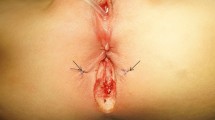Abstract
Eleven females who had a posterior anal transfer (PAT) for a vestibular anus were reviewed in order to: (1) assess the long-term functional success of this operation clinically; (2) evaluate the anorectal manometry profile; and (3) assess defaecation by video proctography. The cosmetic appearance was excellent in all patients. Seven had a good result, 2 a fair result, and 2 a poor result when assessed clinically (Kelly score) in terms of constipation and soiling. The anorectal manometry profile remained within normal limits except in the 2 with a poor result who had diminished sensory awareness of stool in the rectum. PAT does not appear to damage the muscle-sphincter complex, and the children with a large rectum full of faeces seemed to behave like children with acquired megacolon and constipation. Video proctography showed normal defaecatory patterns in all patients. Patient selection is important for this procedure. When PAT was used as the initial treatment a good result was obtained; when it was used to relieve constipation following previous surgery the result was less satisfactory.
Similar content being viewed by others
References
Browne D (1955) Congenital deformities of the anus and rectum. Arch Dis Child 30: 42–46
Bryndorf J, Madsen C (1959) Ectopic anus in the female. Acta Chir Scand 118: 466–478
De Vries PA, Pena A (1982) Posterior sagittal ano-rectoplasty. J Pediatr Surg 17: 638–643
Iwai N, Yanagihara J, Tokiwa K, Deguchi E, et al. (1988) Results of surgical correction of anorectal malformations. Ann Surg 207: 219–222
Keighley MR, Henry M, Bartolo DC, Mortenson NJ (1989) Anorectal physiology measurement: a report of a working party. Br J Surg 76: 356–357
Kelly J (1972) The clinical and radiological assessment of anal continence in childhood. Aust N Z J Surg 42: 62–63
Matley P, Cywes S, Berg A, Ferreira M (1990) A 20-year follow-up study of children born with vestibular anus. Pediatr Surg Int 5: 37–40
Nixon H, Puri P (1977) Results of treatment of anorectal anomalies. A 13–20 year follow-up. J Pediatr Surg 12: 27–37
Ong N-T, Beasley W (1990) Comparison of clinical methods for the assessment of continence after repair of high anorectal anomalies. Pediatr Surg Int 5: 233–237
Santulli T (1962) Rectum and anus. In: Benson C (ed) Pediatric surgery. Yearbook Medical Publisher, Chicago, pp 829–832
Saxena N, Bhattacharyya C (1981) Perineal anal transplant in low anorectal anomalies. Surgery 90: 464–467
Sun W, Read N, Miner P (1990) Relation between rectal sensation and anal function in normal subjects and patients with faecal incontinence. Gut 31: 1056–1061
Zivkovic S, Krstic Z, Vukanic D (1991) Vestibular fistula: the operative dilemma — cutback, fistula transplantation or PSARP? Pediatr Surg Int 6: 111–113
Author information
Authors and Affiliations
Rights and permissions
About this article
Cite this article
Grant, H.W., Moore, S.W., Millar, A.J.W. et al. Is posterior anal transfer a good treatment for vestibular anus?. Pediatr Surg Int 9, 12–16 (1994). https://doi.org/10.1007/BF00176098
Accepted:
Issue Date:
DOI: https://doi.org/10.1007/BF00176098




